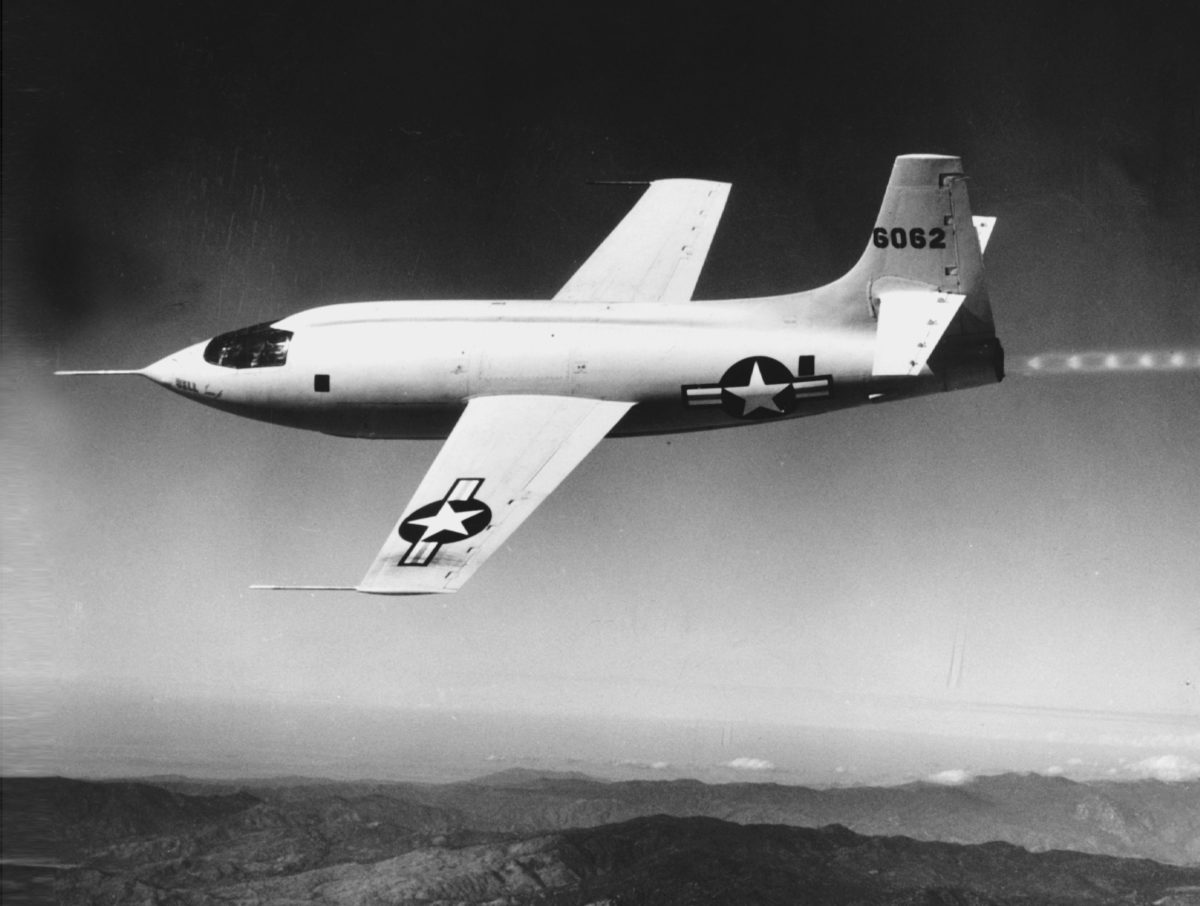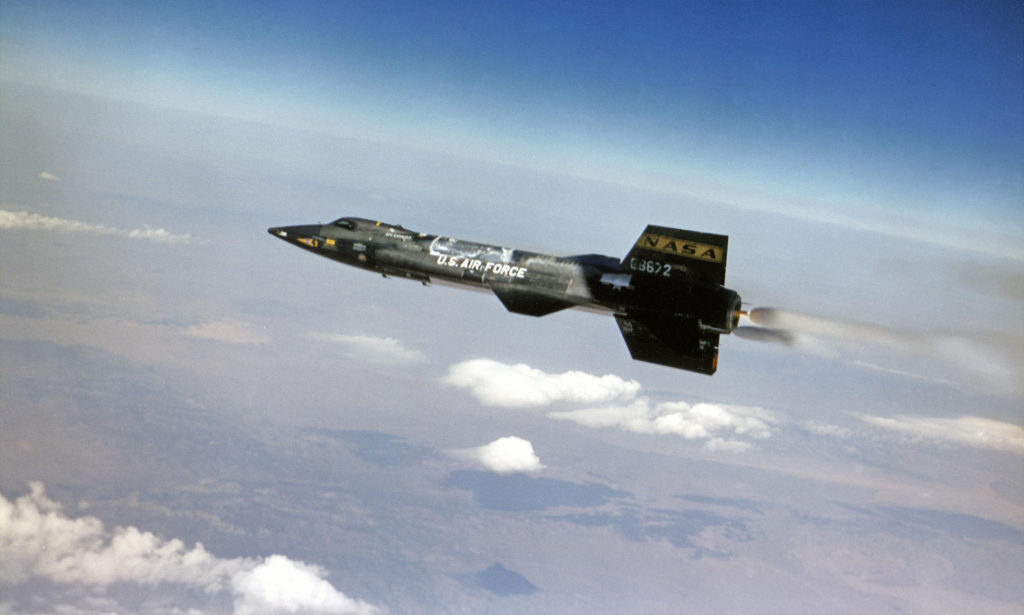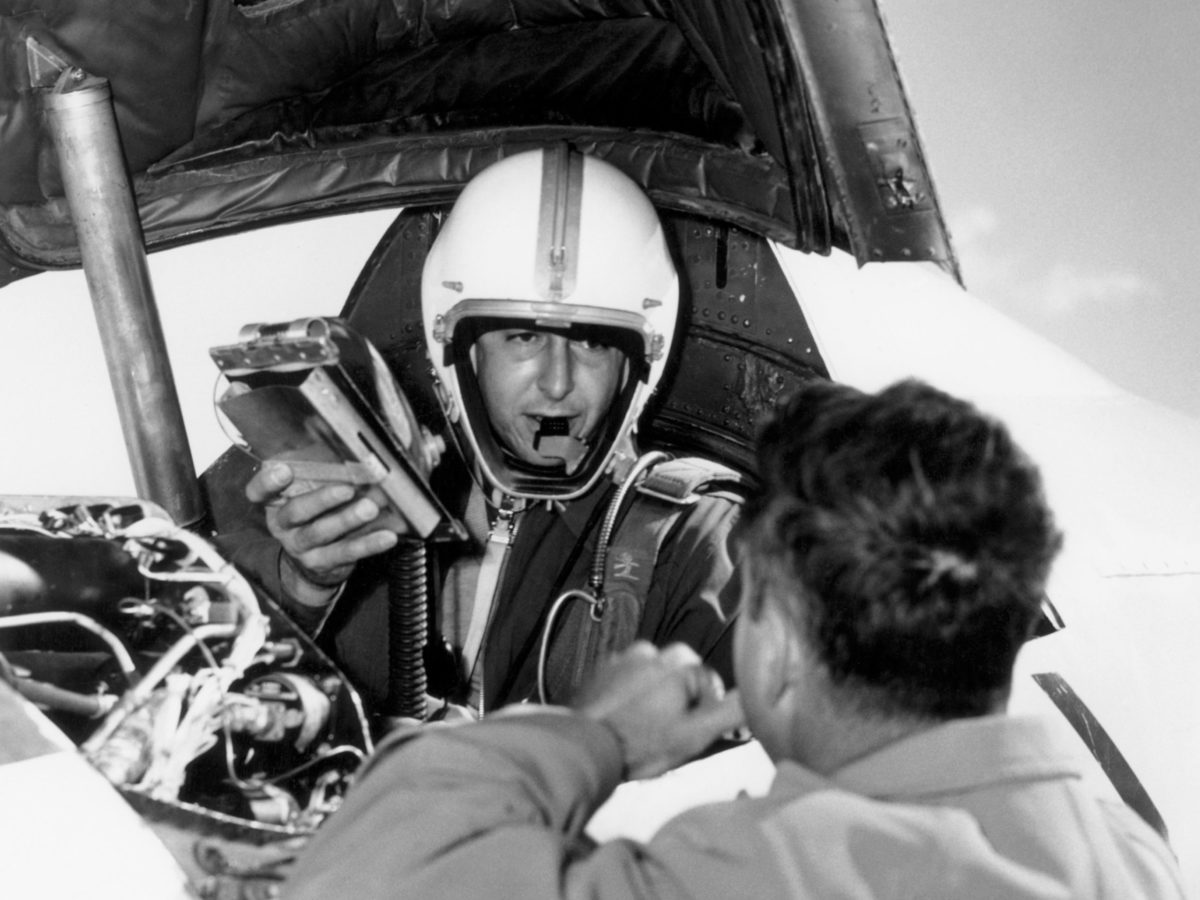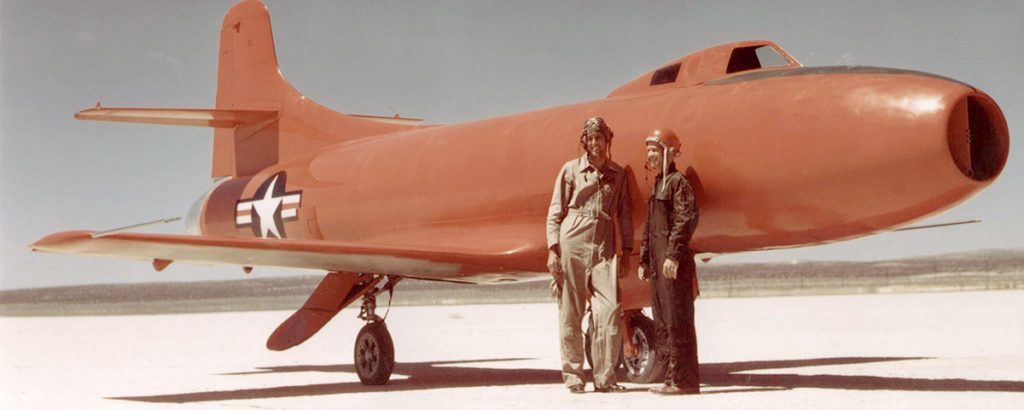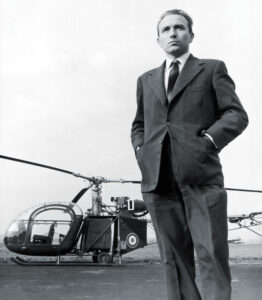On the morning of October 14, 1947, the abrupt double-crack of a sonic boom pierced the tranquility of the Mojave Desert. Piloting the Bell XS-1 rocket-powered research airplane, U.S. Air Force test pilot Captain Charles E. “Chuck” Yeager had just become the first man to exceed the speed of sound, ushering in the era of supersonic flight.
Yeager’s accomplishment earned him a share of the Collier Trophy, aviation’s most prestigious award, together with industrialist Larry Bell (whose firm had designed the little saffron-colored speedster) and aerodynamicist John Stack of the National Advisory Committee for Aeronautics (NACA), the United States’ most prominent advocate for supersonic flight testing and flight research. Beyond that, it launched the country down a path that within a decade would see it fielding operational supersonic jet fighters and interceptors, with supersonic jet bombers in flight test or under development, and bold plans in the offing for commercial supersonic transports and even faster military aircraft and research vehicles.
The path to supersonic flight involved an international effort, with significant contributions by a number of European and American engineers and designers. Under different circumstances, it might have been Britain, Germany or even the Soviet Union that became the first to break the sound barrier, not the United States. That America succeeded first reflected the tremendous energy and power of its aeronautical establishment, which during World War II produced nearly 300,000 airplanes for the U.S. and its allies. It was also a reflection of the comparative strength of America’s robust postwar economy, which made possible vast investment in supersonic research facilities (particularly wind tunnels) and aircraft and missile design programs, something other nations could not readily afford.
The roots of supersonic flight lay in the aerodynamics of the propeller. A propeller is really a rotating wing, generating a horizontal lift-vector, and its tip speeds approach the speed of sound. Just after World War I, engineers at the Army Air Service Engineering Division at McCook Field, Ohio, constructed a small wind tunnel for testing propeller airfoils. Researchers Elisha Fales and Frank Caldwell subsequently found that when the airflow around the airfoils reached 450 mph, the airfoil’s lift abruptly dropped and its drag rose sharply. They had stumbled upon the phenomenon of aerodynamic “compressibility,” the first inkling of the problems high-speed aircraft would encounter in the late 1930s. Other researchers at the Bureau of Standards built upon this earlier Army work. Hugh Dryden and Lyman Briggs undertook pressure distribution studies of airfoils at the speed of sound, taking the first photographs of shockwave formation on an airfoil as the flow over it exceeded Mach 1. By the early 1930s, George Lewis, director of aeronautical research for NACA (the predecessor of today’s NASA), worried that planes might never operationally exceed 500 mph.
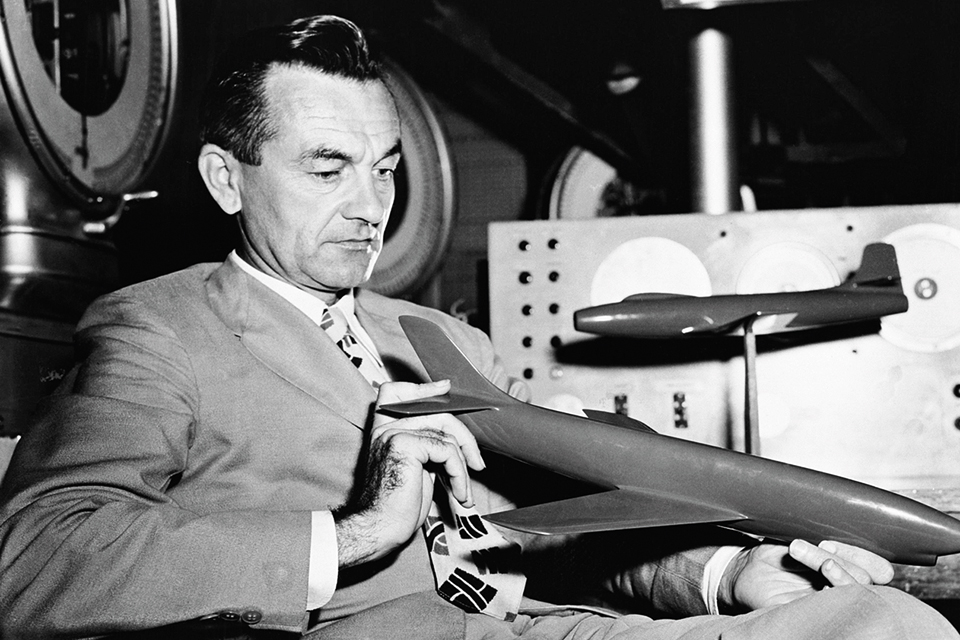
One who thought otherwise was John Stack, a brilliant young engineer at NACA’s Langley laboratory who was already envisioning what a “compressibility research airplane” should look like. In January 1934, he published a technical paper envisioning a prop-driven airplane powered by a 2,300-hp Rolls-Royce R engine, with highly streamlined circular cross-section fuselage and a wing with a thickness-chord ratio (the ratio of the thickness of the wing compared to the distance from leading to the trailing edge) of 18 at the root, decreasing to 9 at the tip. It marked the first conceptual design effort to examine the requirements for a research plane to probe the sonic frontier.
Stack’s design reflected a serious challenge in aeronautics at the time: Wind tunnels could not furnish accurate aerodynamic data at velocities around the speed of sound, where airflow compressed and “bunched up” around a test model. As tunnel speeds increased, shockwaves formed on models and their supports, reflecting back and forth across the test section and generating inaccurate readings.
Since the speed of sound is approximately 760 mph at sea level (dropping to about 660 mph at higher altitudes), and since the world airspeed record was then only 440 mph, this might have seemed a distant problem. But in fact it was not. A propeller blade or airplane wing passing through the air at roughly three quarters the speed of sound has accelerated flow passing over it at the speed of sound or even faster. Propellers lose their efficiency, and wings experience an abrupt decrease in lift and increase in drag. Turbulence streaming behind them buffets tail surfaces, sometimes causing catastrophic structural failure or reducing control effectiveness so that an airplane dives uncontrollably to earth. From the mid-1930s into the post-WWII era, a number of aircraft, typically new fighters, broke up as pilots overstressed them while attempting to recover from high-speed dives at near-sonic velocities. These included the Messerschmitt Me-109, Hawker Typhoon and Lockheed P-38 Lightning. Both prop-driven and newer jet aircraft were equally susceptible.
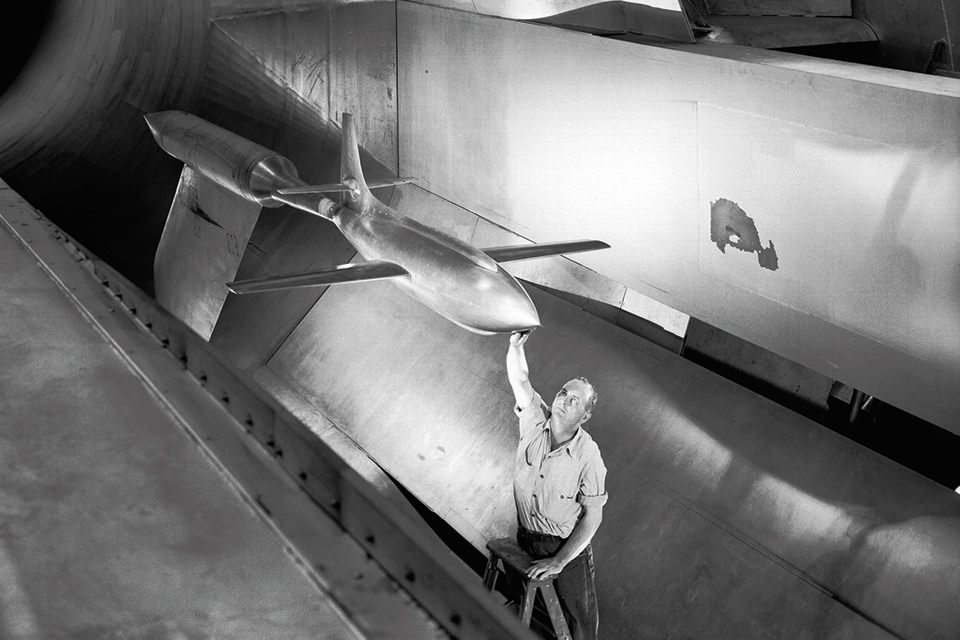
After WWII, NACA aerodynamicists (under Stack’s leadership) eventually developed a “slotted throat” wind tunnel that permitted shock waves to exit the tunnel. That change and the development of the “sting mount” for wind tunnel models would dramatically increase the fidelity and reliability of wind tunnel data. But until that happened, researchers had little option other than flight-testing models and full-size aircraft if they wanted reliable airflow data.
By the mid-1940s, American researchers had developed a number of alternative test methods that, if not perfect, at least furnished some reliable information. These included dropping instrumented test shapes from high altitude, firing instrumented rocket-propelled models and placing small models on the wings of North American P-51s, with test instrumentation in the gun bay, so that the models would be exposed to the accelerated transonic flow over the wing as the Mustang dived earthward at Mach 0.75. That method, conceived by NACA engineer Robert Gilruth, proved surprisingly useful, though it involved some risk to the pilot as he dived at high speed deep into the dense lower atmosphere. Given the short test times, scaling errors and pilot risk involved in these methods, however, researchers increasingly considered developing piloted jet or rocket-propelled research planes that, carrying extensive instrumentation, could cruise in level flight at high speeds and altitudes, effectively using the sky as a laboratory.
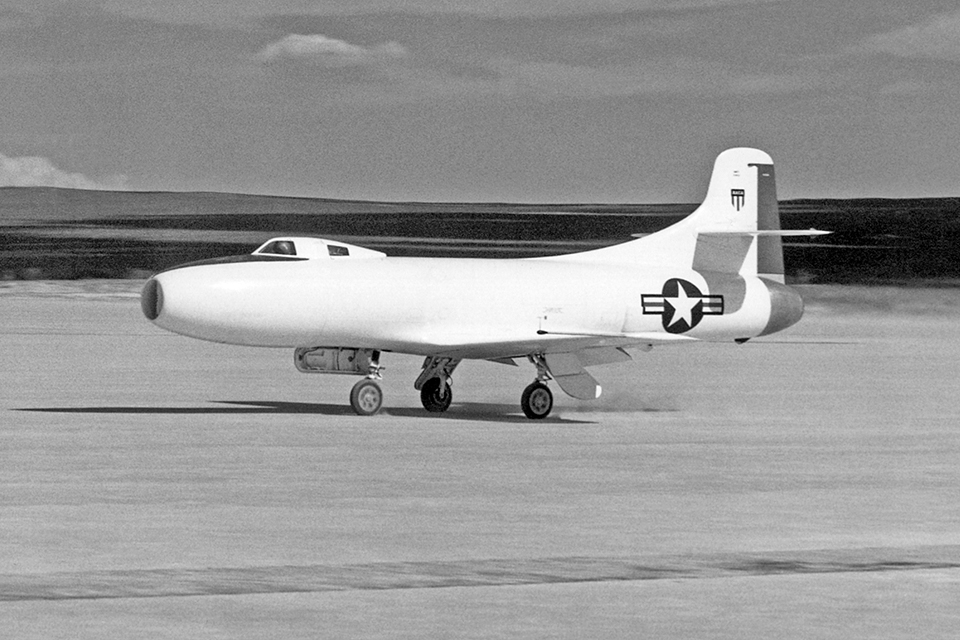
The federal government’s growing interest in developing specialized sonic research airplanes coalesced after an Army Air Forces/ Navy/NACA meeting on March 16, 1944, at Langley resulted in a variety of service-supported design studies. Two very different research planes emerged: the Bell XS-1, sponsored by the Army’s Air Technical Services Command, and the Douglas D-558, funded by the Navy’s Bureau of Aeronautics. Of the two, the D-558 was the more conservative, with a thicker wing section (10 percent versus 8 percent on the XS-1), turbojet propulsion (instead of the XS-1’s more risky and higher-performance rocket engine) and a retractable landing gear (rather than relying only on air-launching, as with the XS-1). That the XS-1 was more radical reflected a largely unsung Army Air Forces engineer, Major Ezra Kotcher, who realized that seeking higher performance required rocket, not jet, propulsion. In mid-1944 he undertook a “Mach 0.999” design study (a tongue-in-cheek reference to the “impenetrable sonic barrier”), in conjunction with Sergeant Alex Tremulis, the automotive stylist who would go on to create the legendary postwar Tucker. In late November 1944, Kotcher used Tremulis’ seductive drawing to persuade Bell chief engineer Robert Woods to accept the challenge of building the world’s first supersonic airplane, launching Bell and the Army Air Forces on the path to the XS-1.
In contrast, the D-558 represented a more operationally focused configuration, reflecting the design approach of NACA and the Navy. In late 1944, 1st Lt. Abraham Hyatt, a Marine Corps aeronautical engineer assigned to the Bureau of Aeronautics, prepared a memo advocating a jet-propelled test airplane capable of “super speed,” stipulating a “minimum high speed of 650 miles per hour at sea level, and at least a 10G load limit” (the rival XS-1 had an 18G load limit). In late 1944, bureau officials showed Hyatt’s memo to Douglas engineer L. Eugene Root, asking if the company would be interested in such a project. “I said ‘You bet,’ grabbed it, and ran with it,” Root later recalled. Subsequently designed by the legendary Ed Heinemann, the resulting jet-powered D-558 was so slender it earned the nickname “the flying test tube.”
In October 1935, at the Volta Congress on high speeds in aviation held in Rome, German scientist Adolf Busemann had proposed sweeping a wing back to alleviate the drag rise associated with high-speed flight. Surprisingly, though his audience was filled with leading researchers from around the world, the significance of his simple concept went largely unnoticed. But in Germany, where Busemann had great influence, sweptwing designs were the common currency of aircraft and missile development in the 1940s. By war’s end, the German Research Institute for Soaring Flight was developing the DFS-346, an experimental rocket-propelled supersonic research airplane, and had already launched a winged derivative of the A-4 ballistic missile, the A-4b. During its climb out of the atmosphere, the A-4b became the first winged missile to exceed the speed of sound, though it broke up during reentry.
In the fall of 1944, Robert T. Jones, a gifted aerodynamicist at the Langley laboratory, had independently postulated the concept of the sharply angled delta and swept wing as a means of delaying and minimizing transonic and supersonic drag, basing his work on earlier aircraft and missile design concepts by Michael Gluhareff and Roger Griswold, and the theories of émigré NACA aerodynamicist Max Munk. Like Munk’s ideas, Jones’ work stirred great controversy until, in the late spring of 1945, American researchers sifting through the rubble of the Third Reich’s aeronautical laboratories discovered the tremendous investment German engineers had made in sweptwing and delta aircraft and missiles.
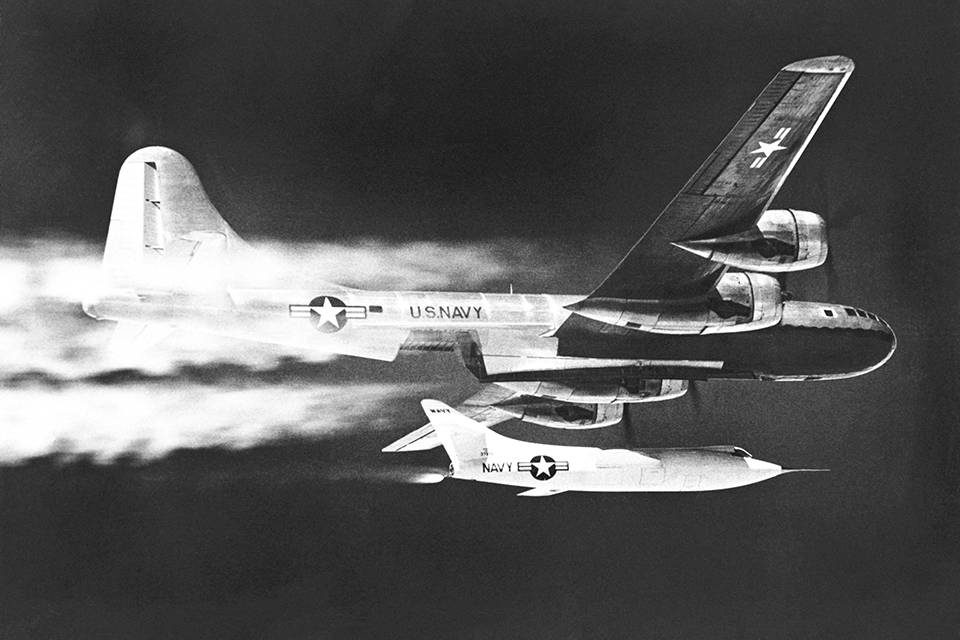
The swept wing immediately went to the top of design priorities for high-speed flight. In the U.S., North American redesigned the XP-86 as a sweptwing airplane; Boeing did the same with a new design that emerged as the XB-47; and Douglas, at Navy request, split the D-558 program into two phases: the straight-wing turbojet-powered D-558-1 Skystreak and the sweptwing jet-and-rocket-powered D-558-2 Skyrocket. (In November 1953, NACA research pilot Scott Crossfield would fly a D-558-2 beyond Mach 2, the first piloted double-Mach flight in aviation history). Abroad, Soviet technical intelligence personnel transported the DFS-346 design team and their families, together with all available technical data, to Russia in late 1946, completing the design and subsequently test-flying it, though with indifferent results. Britain began an ambitious program to exploit German aerodynamic and rocket technology, complementing the design of the Miles M.52, a futuristic and highly refined supersonic configuration begun in 1943. In the summer of 1946, Sir Ben Lockspeiser, then director-general of scientific air research at the Ministry of Supply, canceled that remarkable aircraft, an action that Sir Roy Fedden, one of Britain’s greatest engineers, damned a decade later as having cost Britain “at least ten years in aeronautical progress.”
Though more often associated with second-generation supersonic aircraft such as the General Dynamics F-111, Grumman F-14, Mikoyan-Gurevich MiG-23 and Boeing B-1, the variable-sweep wing had its origins in Nazi research. In 1945 Bell’s Robert Woods led a technical intelligence team to Oberammergau, site of Messerschmitt’s advanced projects office, where he discovered the prototype P-1101, a canceled Luftwaffe fighter that designer Woldemar Voigt had hoped to use for sweptwing research by installing wings of varying sweepback. Together Voigt and Woods conceived of something very different: installing a pivot on a movable track inside the fuselage so that wing sweep could be varied in flight. This resulted in the Bell X-5, the world’s first variable-sweep aircraft, which closely resembled the P-1101.
Bell built two X-5s, testing the variable-sweep principle up to Mach 1.05, though one was lost due to its vicious spinning characteristics, killing test pilot Major Ray Popson. The Air Force briefly considered exporting an armed version of the X-5 as a NATO fighter, but did not. Meanwhile, the Navy evaluated a Grumman design, the XF10F-1 Jaguar, which featured a generally similar wing planform, though the Jaguar’s performance was so mediocre—even dangerous—that it did not warrant introduction to the fleet. The variable-sweep concept would remain just an attractive idea until the advent of the outboard pivot concept, which made it far more practicable, enabling development of the 1960s-era F-111 and MiG-23.
Not all the German-rooted ideas worked out. Designers in Britain and America swiftly emulated Alexander Lippisch’s tailless rocket-powered Me-163 Komet, building similar (though jet-powered) designs, the de Havilland D.H.108 Swallow and Northrop X-4 Bantam. In service, though, the Me-163 had proved dangerously unstable, as fluctuations in the wing’s center of pressure triggered poorly damped longitudinal pitching, imposing high structural loads. (Pilots compared it to riding over a washboard road.) The Swallow killed experienced test pilot Geoffrey de Havilland (son of the firm’s founder) on September 27, 1946. Flying low over the Thames estuary at Mach 0.875, the aircraft abruptly pitched out of control and broke up. Learning from that tragedy, Northrop’s X-4 test team flew at higher altitudes, where the penalty for such a divergent pitch was less threatening.
Likewise, postwar tests of Lippisch’s proposed DM-1 delta glider proved its wing and tail sections were too thick, creating high drag and unacceptable stability and control problems. Instead, when Convair designers embarked on their own delta designs, they started with a sharply sweptback thin wing, then gradually filled in its trailing edge until they arrived at a classic 60-degree delta planform. Thus, contrary to popular belief, Lippisch’s wartime delta research had no impact on the XF-92A, the F-102 or any other of the later Convair designs.
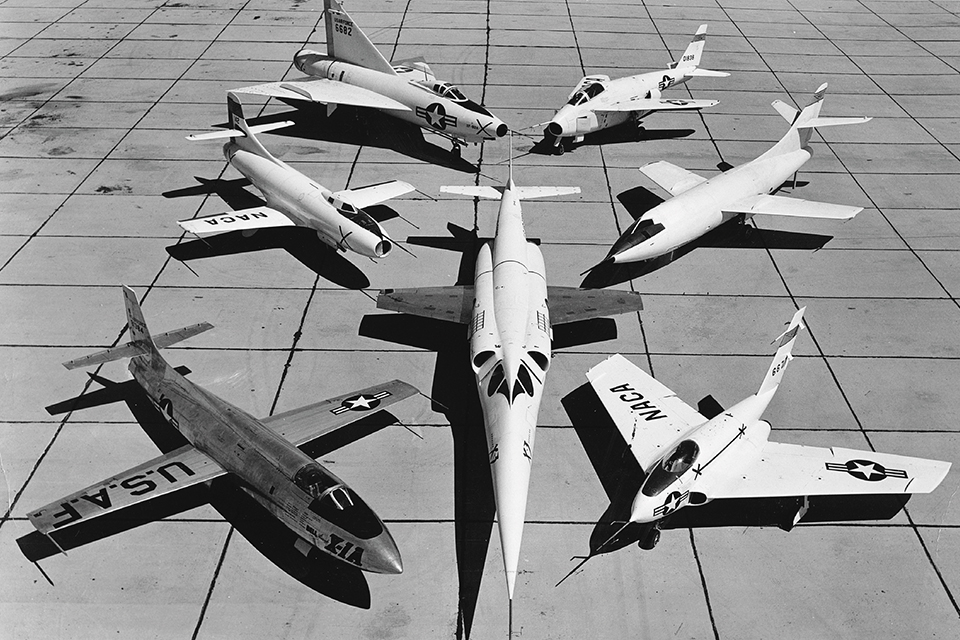
The advent of the swept and delta wing, and recognition that efficient supersonic flight demanded wings with much higher fineness ratio and much lower aspect ratio, led to a reshaping of aircraft design. Changing wing design—combining very thin airfoil sections with low-aspect-ratio planforms (such as the short-span straight wings of the Douglas X-3 and Lockheed F-104), swept wings (e.g., North American F-100 and Vought F8U), deltas (Convair’s F-102, F-106 and B-58) or variable-sweep wings (X-5)—was crucial to achieving practical supersonic flight. With such changes came increased requirements for stiffness and rigidity, to prevent flexing and potential structural breakup of the wing.
The ratio of fuselage length to wingspan also changed dramatically. The shift in ratio had occurred progressively as aircraft flight speeds increased. From the time of the Wrights through the interwar era, wingspan had generally exceeded fuselage length; at WWII’s end, with the first jets, fuselage length and wingspan had been approximately equal. But in the supersonic era fuselage length increasingly exceeded wingspan. This resulted in spectacularly streamlined shapes that, prior to the era of stability augmentation and electronic flight control, were plagued by dangerous instabilities.
One problem was pitch-up: As a sweptwing airplane approached a stall, the onset of stall would begin at the tips (reducing roll control effectiveness) and progress inward, with the aircraft’s center of pressure moving forward. This could lead the plane to abruptly pitch upward, possibly stalling completely—a potential killer at low altitude. Pitch-up limited the combat performance of both the North American F-86 Sabre (America’s first sweptwing jet fighter) and the MiG-15, its chief opponent (many of which pitched up during turning combat, entering unrecoverable spins). Tail placement was crucially important, with aircraft such as the T-tail McDonnell F-101 and the F-104 particularly susceptible to mission-limiting pitch-up. As a result, the T tail, though fashionable early in the supersonic era, quickly gave way to the low tail, as exemplified by the F-100, F8U-1, Republic F-105, Grumman F11F-1 and Northrop T-38/F-5—all with their horizontal stabilizers placed at the bottom of the fuselage. Aircraft that could not take advantage of such placement, such as the McDonnell F-4H-1 Phantom II, employed pronounced anhedral (negative dihedral) as a solution.
Equally important was the “all-moving” tail, which increased the effective elevator area and deflection by pivoting the entire horizontal tail surface as a single unit. Demonstrated with the XS-1 (which lacked a true all-moving tail but had a movable horizontal stabilizer as well as a conventional elevator), the concept was employed on the F-100 and subsequent supersonic Air Force and Navy-Marine aircraft.
Inertial coupling, also called roll coupling, was another potentially dangerous problem. This phenomenon, induced by rapidly rolling an aircraft that had most of its mass distributed along the length of the fuselage rather than along the span of its wing, plagued a number of new designs, including the D-558-2, the long-fuselage advanced Bell X-1 family, the Bell X-2, the X-3 (tellingly nicknamed the “Stiletto”), the X-5 and virtually all the early supersonic jet fighters. All of them, if rapidly rolled at transonic and supersonic speeds, would tend to “couple” into combined rolling, pitching and yawing motions, with the airplane tumbling out of control. At high speeds and “high q” (high dynamic pressure), results could be catastrophic.
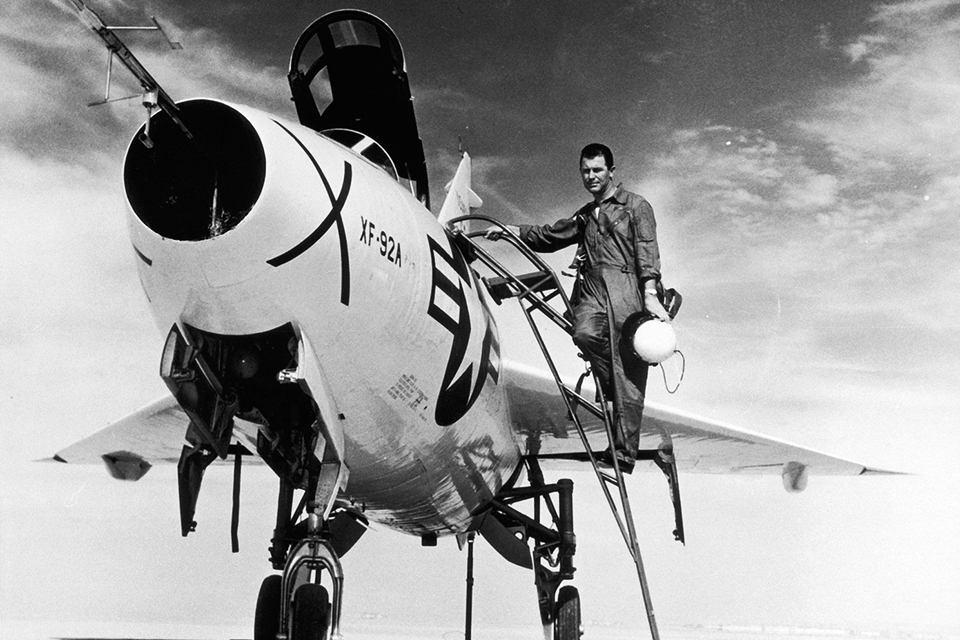
In December 1953, inertial coupling sent the Bell X-1A out of control at Mach 2.44, resulting in a tumbling, spinning descent. It required every bit of Chuck Yeager’s legendary piloting skill to recover the airplane and then glide back to a landing at Edwards Air Force Base. In 1954 North American test pilot George Welch was less fortunate; inertial coupling during a supersonic rolling dive pullout in an experimental F-100A Super Sabre led to its fatal breakup. Two years later inertial coupling contributed to the death of Air Force Captain Milburn “Mel” Apt after he turned back to Edwards in X-2 No. 1 after reaching Mach 3.2. Apt, who was experienced in inertial-coupling research, may have been misled by lagging instrumentation readings into thinking the X-2 was flying slower than it actually was.
The solution to inertial coupling was increasing the size of vertical surfaces and adding stability augmentation to flight control systems. Production F-100s had larger vertical tails and slightly larger wings, changes also seen on aircraft such as the F-105, F8U-1 (which featured ventral strakes as well) and North American A3J-1 Vigilante. Single tails gave way in the 1960s and 1970s to twin tails, beginning with the MiG-25 Foxbat and F-14A Tomcat. (North American’s first concept for the A3J-1 envisioned twin fins, which would have anticipated the Foxbat’s configuration by a decade).
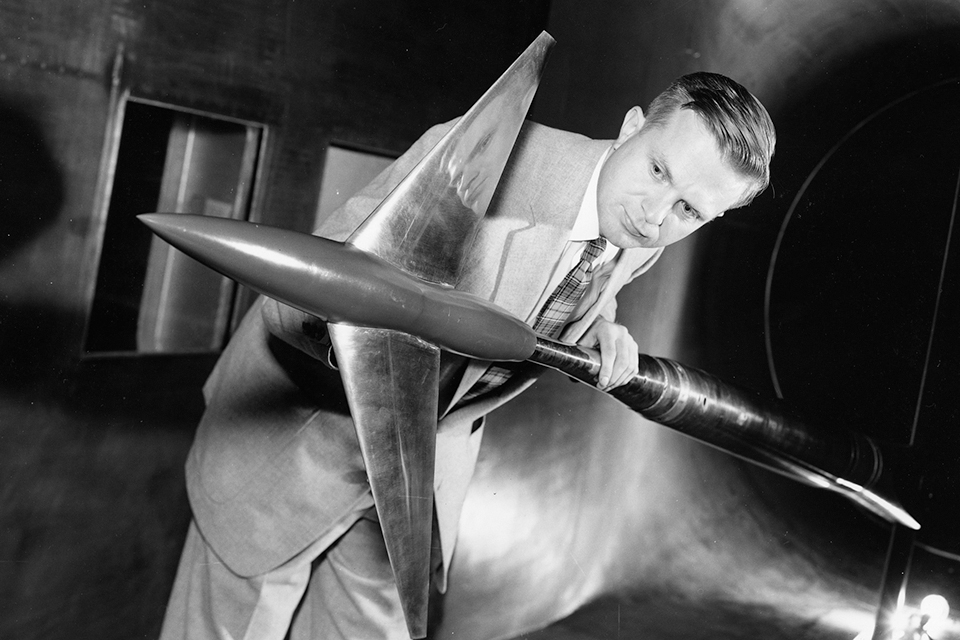
One more significant design change remained before the United States could exploit routine supersonic flight—and like low-aspect-ratio wings, increased fuselage length, larger vertical fins and low-placed horizontal stabilizers, it was readily visible to the casual eye. This was area ruling, as manifested in the classic “Coke bottle” fuselage shape. As Grumman’s F9F-9 Tiger and Convair’s F-102 interceptor moved toward flight testing, researchers noted that their anticipated drag based on wind tunnel tests was higher than it should be. It took a young NACA fluid dynamicist, Richard T. Whitcomb, to puzzle out the answer. An airplane, he reasoned, could be envisioned as a smoothly expanding and contracting symmetrical body of revolution, elongated as much as practically possible to reduce abrupt drag-inducing discontinuities. Where protrusions had to be made—for example, the wings—the fuselage could be effectively pinched to “fool” the air into thinking the body was more streamlined than it actually was. Whitcomb’s notion saved the Grumman and Convair designs, each of which, in their initial flight test configuration, had proved woefully deficient. Both companies lengthened their respective airplanes and applied area rule to their design. The Grumman design became the F11F-1, best known as the famed Blue Angels’ demonstration aircraft, and the F-102 went on to become a mainstay of USAF Air Defense Command through the middle years of the Cold War.

this article first appeared in AVIATION HISTORY magazine
Facebook @AviationHistory | Twitter @AviationHistMag
By the time Sputnik’s beeping shocked Americans out of their complacency, the transformation of Uncle Sam’s aeronautics from subsonic to supersonic was essentially complete. Hand in hand with progress in design theory had come critical advances in air-breathing flight propulsion, without which supersonic flight would have remained an elusive dream, reached only by experimental rocket planes. The large-diameter centrifugal-flow turbojet that predominated in the early subsonic jet era gave way to axial-flow, variable-compressor, multiple-spool jet engines offering increased performance. Due to their smaller diameter and higher thrust-to-weight ratios, these were more suitable for the supersonic aircraft of the 1950s. The afterburning Curtiss-Wright J65, the General Electric J79 and J85, and the Pratt & Whitney J57, J58 and J75 made possible aircraft such as the “Century Series” fighters and other Cold War stalwarts. What’s more, those aircraft enjoyed the emerging benefits of the rapidly unfolding avionics revolution, with force-multiplying technologies such as advanced electronic fire control and air-to-air missiles. If much of this seems rudimentary by present-day standards, it was still impressive by the standards of the late 1950s.
As 1958 dawned, American aerospace was firmly fixed within the supersonic era. Both promise and disappointment lurked in the future: the promise of greater flight efficiencies and capabilities made possible by the advent of very high thrust-to-weight after burning turbofans and electronic flight control (typified by the F-15 and F-16), and the disappointment of overexpectations evident in the drive to build a commercial American supersonic transport. Altogether it had been a spectacular ride, however, effectively doubling flight speed every 10 years from 1938 to 1958, from Mach 0.5 to Mach 2. Achieving practical supersonic flight had taken insight, dedication, commitment, expertise and plenty of courage. Fortunately, those were all qualities America’s supersonic pioneers possessed in abundance.
Former U.S. Air Force historian Richard P. Hallion is the author of numerous aviation articles and books, including Supersonic Flight: Breaking the Sound Barrier and Beyond, which is suggested for further reading. Hallion also recommends: Faster, Further, Higher: Leading-Edge Aviation Technology Since 1945, by Philip Jarrett; and The X-Planes: X-1 to X-45, by Jay Miller.
This article originally appeared in the July 2011 issue of Aviation History magazine. Subscribe here.

